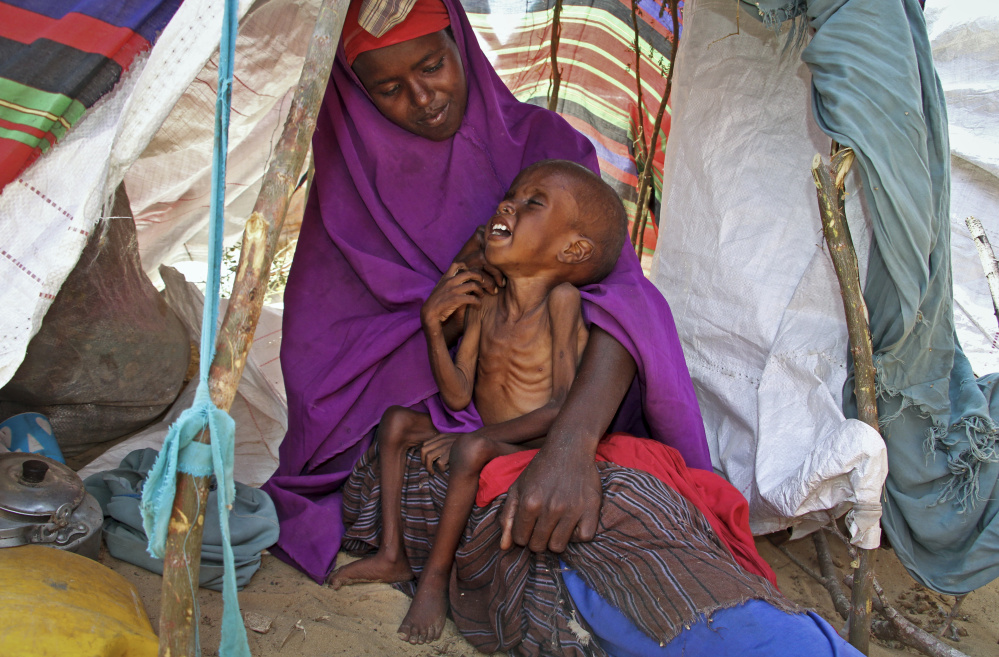NAIROBI, Kenya — At the beginning of this year, the United Nations made one of its boldest requests ever for funding. It needed billions of dollars to fund a humanitarian response, said Secretary General António Guterres, or as many as 20 million people might starve to death.
Five months later, the results of that appeal are dismal. The United Nations has raised about a third of its goal, and there’s little reason to believe that much more is coming.
The funding is for four countries facing massive hunger crises: South Sudan, Somalia, Nigeria and Yemen. Of the $6.1 billion requested for those countries, only $2.2 billion has been pledged.
In each crisis, according to aid officials, the lack of funding has led to a reduction in food assistance for those in need. It remains unclear how many lives have been lost because of the lack of funding, but the United Nations has recently unveiled stark statistics about the unmet need.
This month Guterres warned that a Yemeni child dies every 10 minutes of preventable causes such as conflict, hunger and disease. UNICEF has said that more than 275,000 children across Somalia are facing severe malnutrition. In South Sudan, the United Nations says that 2,800 people are fleeing worsening violence and looming famine every day.
“It means, quite simply, that large numbers of people, particularly children, will suffer and die,” said Andrea Tamburini, chief executive of Action Against Hunger.
The funding shortfall comes at a particularly troubling time, with some regions in the affected countries about to enter the “lean season,” as families exhaust their last reserves from the previous harvest.
Of the four crises, the United Nations’ biggest shortfalls are in Nigeria, where only 28 percent of $1.05 billion requested has been raised, and in Yemen, where 23.7 percent of the $2.1 billion appeal has been funded.
That funding gap is already being felt in northeastern Nigeria, where 1.8 million people are in need of food assistance, many of them living in makeshift displacement camps in bombed-out cities.
In the absence of funding, the World Food Program this month had to abandon its plans to feed about 500,000 of the nearly 2 million in need, instead focusing on the most urgent cases.
“When you can no longer feed, say, all malnourished children in a certain age group in a given area, you operate a form of triage. It is a moral wrench to do this, but we don’t have much choice,” said Andre Vornic, a WFP spokesman.
Raising funds for hunger crises, particularly in Africa, is never easy. In 2011, the United Nations struggled to galvanize donors during a famine in East Africa. In Somalia alone, 260,000 people died during that crisis, though a lack of funding wasn’t the only reason for that massive loss of life. Aid delivery had been complicated by al-Shabab militants.
Many in the aid community worried that the Trump administration’s budget, which proposed massive cuts to foreign aid, would be disastrous for the international humanitarian response. But so far, the United States is still donating more than other nations in many cases.
In Nigeria, the United States is contributing $25 million to the WFP budget this year, three times as much as Canada, the next-largest donor.
Send questions/comments to the editors.



Success. Please wait for the page to reload. If the page does not reload within 5 seconds, please refresh the page.
Enter your email and password to access comments.
Hi, to comment on stories you must . This profile is in addition to your subscription and website login.
Already have a commenting profile? .
Invalid username/password.
Please check your email to confirm and complete your registration.
Only subscribers are eligible to post comments. Please subscribe or login first for digital access. Here’s why.
Use the form below to reset your password. When you've submitted your account email, we will send an email with a reset code.